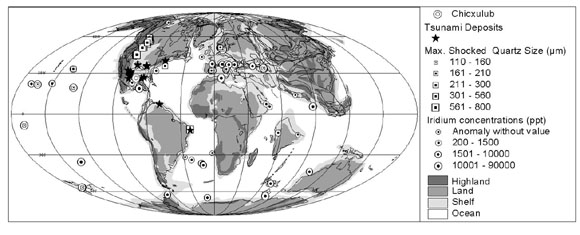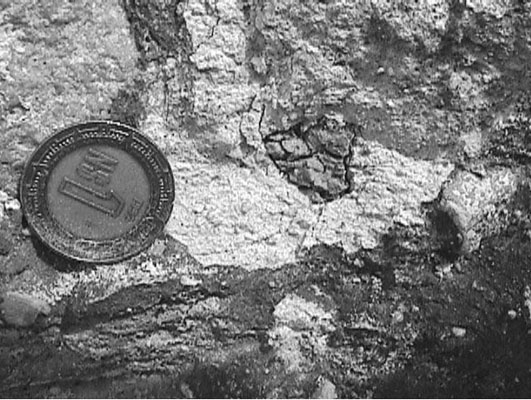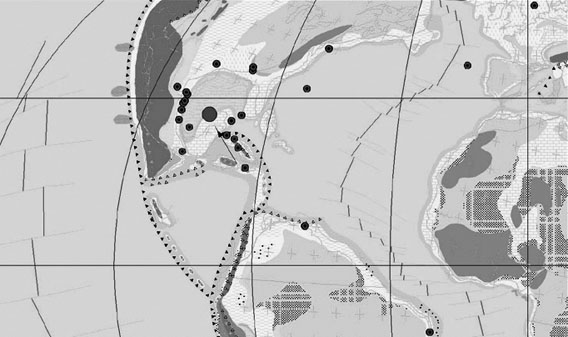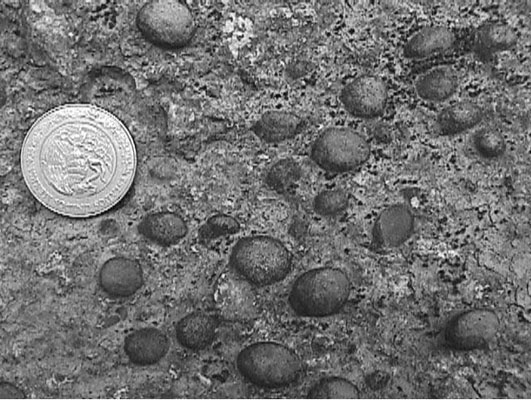Philippe Claeys
Department of Geology, Vrije Universiteit Brussel, Pleinlaan 2, B-1050 Brussels <phclaeys@vub.ac.be>
This talk will review the processes of ejecta formation and the distribution of these solid, molten and vaporized debris all over the world during the Chicxulub impact event. Chicxulub is one of the rare craters on Earth with a well preserved, proximal to distal sequence of ejecta deposits. Chicxulub and the KT ejecta can be thus used as a case study to understand ejecta production, distribution and alteration in sedimentary sequence. The record of ejecta layer in sediment remains rather low. This low record is difficult to reconcile with the cratering rate derived from counting terrestrial craters (Grieve et al., 1995) or from studying the orbits of Near Earth Objects . Several impact layers are known in the Cenozoic, including the Cretaceous-Tertiary boundary, but in the Mesozoic and Paleozoic, only rare and often controversial layers are found. Some ejecta layers are often problematic to link with a known impact structure, and for many structure the ejecta layers remain undiscovered.

Figure 1. Distribution of Ir concentration, and shocked quartz at the KT boundary.
The mineralogical, sedimentological, geochemical and palentological information extracted from the studies of KT boundary sites worldwide has been incorporated in a large database. It is used to document the distribution of impact debris at the KT boundary on a latest Cretaceous paleogeographic map (Fig. 1). The succession of ejecta particles can be documented as follows: The thick ejecta blanket consisting of a polymict breccia mixing basements, evaporite and carbonate clasts is encountered in shallow wells just outside the crater rim. This “Bunte breccia” equivalent is covered by fall-out suevite in the shallow wells drilled at the crater rim. In Quitana Roo, Campeche and Belize, the ejecta blanket is formed by a > 20 m thick diamictite-like breccia with large (>10 m) dolomite blocks (Ocampo et al., 1996). The breccia rests on upper Cretaceous stratified dolomite which bedding becomes progressively fractured upward. Basal Paleocene strata (P. eugubina Zone) is apparently missing above the diamictite. Little primary crater material occurs in the breccia, mainly in the form of millimeter-size greenish spherules (Fig. 2). Locally metric-size pockets of pure clay mineral are visible. They resemble glass-bombs and contain millimeter-size fragments similar to the basement clasts from the Chicxulub suevite.

Figure 2. Green spherules are most likely altered melted particles, which were incorporated into the ejecta blanket.
In Southern Mexico, the Chicxulub impact triggered the collapse of the margins of the Yucatan platform and the chaotic accumulation of shallow-water carbonate blocks in the deep water. This breccia forms a good oil reservoir rock of the producing fields offshore Campeche (Grajales-Nishimura et al., 2000). Similar impact induced mass failures of the slopes are now reported on both margins of the Atlantic Ocean (Fig. 3). At the El Guayal site near Villahermosa, a sandy layer, up to 2 m thick is sandwiched between this carbonate breccia and the classic Ir-rich layer. It contains shocked material and large lapilli particles, comparable to those found in the Ries crater suevite (Graup, 1981). This could indicate that the deposition of fall-out suevite extended to a distance of more than 600 km from the crater center.

Figure 3. Distribution of sediment indicative of tsunami related deposition in the Gulf of Mexico region and further away in the Atlantic of mass flow deposition, probably caused by major seismic disturbance related to the Yucatan impact.
All around the Gulf of Mexico region, a succession of ejecta material, coarse sand and fining upward Ir-rich sequence occurs (Smit et al., 1992). It documents the rapid deposition of molten and shocked debris from the ejecta curtain, followed by the sedimentological consequences of tsunami or mega-waves (Fig. 4) and finally at its top, the settling of the finer particles enriched in platinum group elements. The glass 40Ar-39Ar age as well as chemistry and isotopic compositions closely resembles that of the Chicxulub crater impactites (Blum et al., 1993; Claeys et al., 1993; Swisher et al., 1992). In the US Western Interior, this same succession forms the double layer of impact spherules and shocked quartz (Izzet, 1990).

Figure 4. Lapilli unit in the El Guayal KT site. These grains formed in a turbulent environment incorporated tiny-shocked quartz crystals in their concentric layers. Their bulk chemistry shows similarities with the phases believed to be present in the Chicxulub vapor plume (Salge and Claeys, 2000)
This succession supports the almost simultaneous deposition (Alvarez et al., 1995) first of the altered glass spherules from the Chicxulub ejecta curtain, rich in molten products, shortly followed by the classic PGE-rich layer from the vapor cloud. In the rest of the world, Chicxulub ejecta forms the classic clay unit enriched in Ir, which is widely recognized to mark the KT boundary, and will be visible during the field trips to Agost and Caravaca.
References
Alvarez, W., Claeys, P., and Kieffer, S. W. 1995. Emplacement of KT boundary shocked quartz from Chicxulub crater. Science 269, 930-935.
Blum, J. D. et al. 1993. Isotopic comparison of K/T boundary impact glasses with melt rock from the Chicxulub and Manson impact structures. Nature 364(6435), 325-327.
Claeys, P. et al. 1993. KT boundary impact glasses from the Gulf of Mexico region. 24th Lunar and Planetary Science Conference, 297-298.
Grajales-Nishimura, M. et al. 2000. Chicxulub impact: The origin of reservoir and seal facies in the southeastern Mexico oil fields. Geology 28, 307-310.
Graup, G. 1981. Terrestrial chondrules, glass spherules and accretionary lapilli from the suevite, Ries crater Germany. Earth and Planetary Science Letters 55, 407-418.
Grieve, R. A. F., Rupert, J., Smith, J., and Therriault, A. 1995. The record of terrestrial cratering. GSA Today 5(189), 194-196.
Izett, G. A. 1990. The Cretaceous/Tertiary boundary interval, Raton Basin, Colorado and New Mexico, and its content of shock-metamorphosed minerals; evidence relevant to the K/T boundary impact-extinction theory. Geological Society of America Special Paper 249, 1-100.
Ocampo, A. C., Pope K. O., and Fisher A. G. 1996. Ejecta blanket deposits of the Chicxulub crater from Albion island, Belize. In The Cretaceous-Tertiary Event and Other Catastrophes in Earth History, Vol. Special Paper 307 (ed. G. Ryder, D. Fastovski, and S. Gartner), pp. 75-88. Geological Society of America.
Salge, T. and Claeys, P. 2000. Accretionary lapilli from the Cretaceous-Tertiary boundary site of Guayal, Mexico; preliminary insights into expansion plume formation. Meteoritics & Planetary Science 35(5), 140-141.
Smit, J. et al. 1992. Tektite-bearing, deep-water clastic unit at the Cretaceous-Tertiary boundary in northeastern Mexico. Geology 20, 99-103.
Swisher, C. C. et al. 1992. Coeval 40Ar/39Ar ages of 65.0 million years ago from Chicxulub Crater melt rock and Cretaceous-Tertiary boundary tektites. Science 257, 954-958.